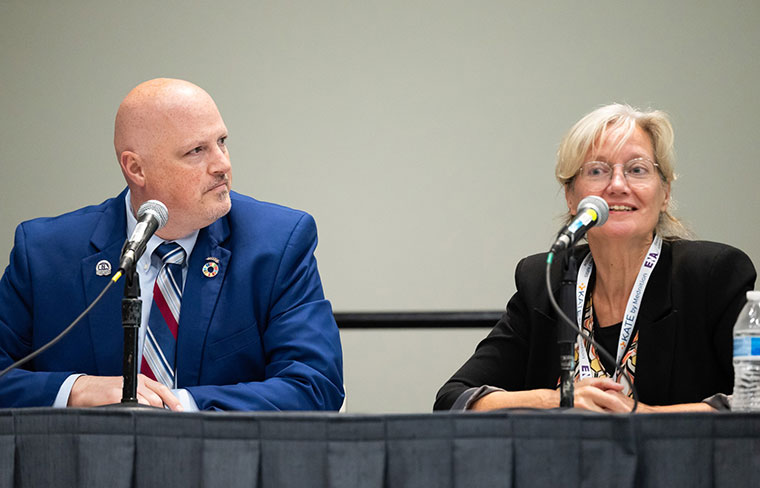
Emergency Nursing 2023 offered attendees significant opportunities to visit with their counterparts from around the world and see how different — and alike — their emergency departments and practices are.

Ever wonder if ED nurses around the world experience the same patient complaints day in and day out? What about throughput, crowding or boarding issues?
The session “Global Perspectives in Emergency Nursing: What Can We Learn from Each Other?” featured ED nurses from Ireland, Columbia, the United Arab Emirates, Hong Kong and the Netherlands talking about their daily challenges. The discussion raised many valuable commonalities and differences.
For example, the session speakers shared how they handle patients who come to the ED regularly — known as frequent flyers. Rafael Pineda-Perdomo, BSN, RN, said EDs in Colombia have very few frequent flyers because most visits require a minimum of two or three days, which discourage those patients.
Hong Kong hospitals do see frequent flyers, but when they are identified, a social worker is assigned to help them with issues that may be causing the frequent visits, according to Cheung “Terrance” Kai Yeung, DNurs, Bnurs (1st Hons), RN, PgD (AENP), FHKAN (Emergency).
Hospitals in the Netherlands also have frequent flyers, M. Christien van der Linden, PhD, RN, CEN, ENP, MSCE, noted. But only about a half percent of her ED patients fall into that category, thanks to the strong system of referrals from general practitioners.
Another global session focused on the numerous triage systems in use in EDs around the globe. The session “We Are More Alike Than We Are Different: An International Triage Overview” explored the four major triage systems: Emergency Severity Index, Canadian Triage Acuity Scale, Australasian Triage Scale and Manchester Triage System.
Subtle differences exist between the triage systems’ discriminators that determine the level of urgency. For instance, the Canadian system’s first level of discriminators includes respiratory distress, level of consciousness, temperature and hemodynamic status. The Manchester Triage System’s first discriminators include airway compromise, inadequate breathing and shock.
“I would say the most controversial part of this is [the Manchester Triage System’s] discriminator for pain because, within the Manchester Triage System, pain is whatever the patient says it is,” said Alison Day, PhD, RN, FAEN, chairperson of the ENA International Advisory Council.
“No matter the system, it’s about getting the patient to the right place at the right time with the right treatment,” said Dawn Peta, BN, RN, ENC(C), of Canada, a clinical nurse educator, former IAC member and co-presenter.
The session also covered the fascinating history of triage. “The concept of triage is not new. It has been around since Egyptian times, but the term ‘triage’ started in France,” explained Walter Sergio Lugari, BSN, RN, FKP-NP, of Germany and 2022 chairperson of the IAC.
Triage innovations originating from World War I, World War II and other wars, along with societal shifts in how the general population uses EDs, have required triage systems to evolve to meet today’s needs, he said. As the concept of triage evolved from the battlefield to hospitals in the 1960s, triage began to be used on the civilian population. Today, new concepts have been developed, including telephone triage for patients calling on health services trying to get priority.
“We have a lack of doctors and nurses, so we have to try to figure out how to best create a system in order to help as many people as possible,” Lugari said.
In addition to educational sessions, attendees had the opportunity to network with their peers from around the world. Nurses from Canada, Australia, the Netherlands, Malaysia, Hong Kong and elsewhere gathered at the Global Meet and Greet.
“You think you’re isolated,” said Trent Moser, RN, an IAC member from Canada, “but it doesn’t take long for people to realize they often face similar experiences and challenges wherever they live.”
Nancy Kemmers, RN, APN, of the Netherlands, attended Emergency Nursing 2021 in Orlando and was glad to be back at this year’s conference.
“I remember from Florida I was really excited to [go back to] work in the ER,” Kemmers said. “You’re more inspired.”
At the Global Luncheon and Innovation Session, attendees had another chance to mingle with emergency nurses from other countries as well as participate in a guided session in which they were assigned a topic to discuss at their tables and shared their observations.
For example, nurses from Iceland, Australia and New Zealand talked about technology, highlighting a system using QR codes common in Iceland. While another group of nurses from the United States, Canada and the Netherlands discussed the different ways nurses are trained on new procedures and how to use new equipment and devices, including their interactions with vendors.
Day said she was pleased to see the turnout at the event, which also touched on enhancing connections, professional development, and patient and community education.
“It was clear that as well as learning and understanding at each table, there was a shared experience across the room despite the diverse range of country representatives in the room,” she said. “We really are more alike than we are different.”

